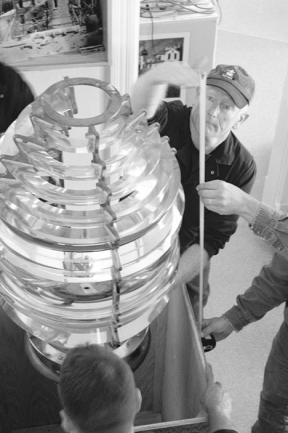A piece of history has returned to Central Whidbey.
A 270-degree fixed Fresnel lens, a light with the exact configuration of one that shone from Admiralty Head Lighthouse, is on loan from the Coast Guard now during the lighthouse’s centennial year.
“It’s spectacular,” said Fred Terrell, who coordinates group tours at the lighthouse and Fort Casey. “To have a second lens, markedly different from the one we have, is wonderful for our centennial.”
A lighthouse has stood at Admiralty Head since 1860. the current structure was lighted in 1902. The structure hasn’t been used as a lighthouse since it was decommissioned in 1922. The lantern was removed in 1928.
The top of the tower, called the lantern room, went to the New Dungeness Lighthouse, near Sequim. Records on the lens itself have been lost.
As tour guides have always been careful to explain, the lens that has been displayed at the Admiralty Head Lighthouse for years never shone over the waters of Admiralty Inlet.
Planning for the lighthouse’s 100th anniversary began months ago. Volunteers have perused state and county archives, trolled library shelves and prowled the Internet to find out as much as they can about the lighthouse. They also ventured down in the landmark’s basement, where a set of blueprints were uncovered.
Lighthouse volunteer Don Roth has poured over vintage maps, diaries and navigation data. Everything from Lighthouse Service records to navigation maps show a 270-degree fixed Fresnel lens at Admiralty Head. “Once a particular light was designated at a particular lighthouse, it rarely changed,” Roth said. “Mariners knew lighthouses had constant lightsources.”
Last June, Roth traveled to the Port Angeles Coast Guard Air Station. As a base for an area Aids to Navigation team, Port Angeles maintains information on area lights. Roth made an exciting discovery in an upstairs hall — a lens exactly like Admiralty Head’s original light. This lens size was the made most often as it could be used as a harbor light or a coastal light in a lighthouse. All plates that might have been engraved with a serial number had been removed, and the Coast Guard property number it bore did not appear on a base property inventory.
Negotiations began between Washington State Parks and the Coast Guard. Because there was no traceable data, no one knows when that light got to Port Angeles or where it came from.
There is speculation that because the Admiralty Head light’s lantern room went to New Dungeness, its Fresnel lens also was sent that direction and could have ended up in Port Angeles. The lens is the right size and has the right direction of prisms to be from Admiralty Head.
James Woodward, environmental protection specialist with the Coast Guard, dates the lens as circa 1870 based on script etched into a metal fitting from a Paris company. He emphasized that the lens could have been made anytime between the 1850s and the 1880s.
Woodward came from Cleveland, Ohio, to assess the lens’ condition and to oversee its trip to Whidbey. He describes the lens as “a high-quality piece of industrial artwork made at the height of the Industrial Revolution.”
Woodward said every company that’s taken a job of making lighthouse glass has refused to make more, saying the process is too complicated. Each step of forming the glass requires exquisite precision. Each side of each prism must be ground to a different angle. Polishing takes three sessions using different levels of grit.
While lenses of this type are not made anymore, experts estimate the value of its components — specialty glass and brass fittings — at $250,000. Each prism, or section of glass, in the lens would cost $5,000 to replace, if a manufacturer could be found.
To historians and lighthouse enthusiasts, this lens is priceless.
Coast Guard, State Parks and Island County/WSU officials along with BeachWatchers and Friends of Admiralty Head Lighthouse watched as a crew carefully installed the lens at the lighthouse July 23.
Moving the lens from the Coast Guard station in Port Angeles to Whidbey Island took two days of “meticulous work,” said Gloria Wallin, Admiralty Head volunteer coordinator. A special crate was built to cradle the bubble-wrapped lens. Moving the approximately 300-pound crate took well-talked-over, slow movements. Plans to lower it from a truck bed took at least 45 minutes. Maneuvering the crate up steps and into the lighthouse took another 25 minutes.
Once the crate had been opened, no one handling the lens could wear watches or rings that might scratch the glass or brass. And only essential movers were allowed near. The team took another 30 minutes to discuss lifting the lens onto its new pedestal.
“I’ve never dropped a lens and I want to keep that record,” Woodward said.



